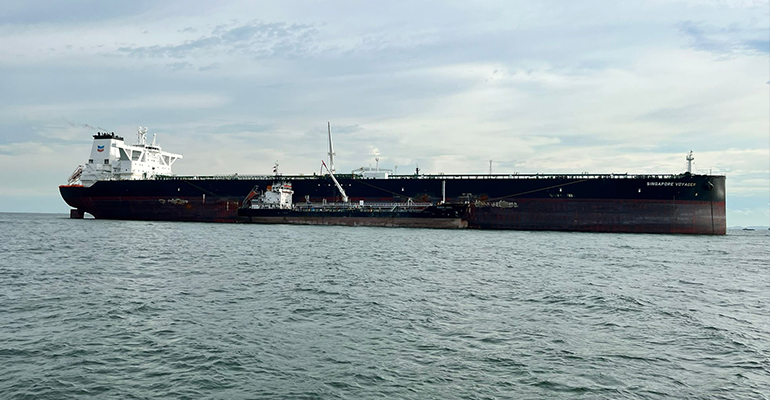A collaborative route to a decarbonised marine industry
A collaborative route to a decarbonised marine industry Seatrade Maritime News


Chevron’s Lubricants Successfully Matched with Biofuels and HSFO

Chevron Marine Lubricants (CML) has concluded that Chevron’s Taro Ultra 140 cylinder oil and Veritas 800 Marine 30 crankcase oil can be successfully matched with a blend of biofuel and high sulfur fuel oil (HSFO).
The tests mark an important breakthrough for the marine industry’s understanding of marine lubricants and biofuels compatibility, especially in blends using cooking oil methyl ester (UCOME) with high sulfur fuel oil (HSFO).
Decarbonisation
The findings are a major landmark on the route to decarbonising the marine sector, providing assurances to vessel operators about the possibility of wider adoption of biofuels in the shipping industry.
The test program also highlights CML’s ability to work with original equipment manufacturers to support their ambitions to adopt the greater use of lower carbon density fuels.
By partnering with original equipment manufacturers, customers, and industry partners, further investigations into emerging fuels with low carbon intensity will be conducted. This includes analytical evaluation and testing programs of different biofuels currently available and their compatibility with different lubricants.
Matthew Lynch, Senior Manager, Global Lubricants Products and Technology at Chevron, stated, “These positive outcomes help build confidence that biofuels may have an important role in future marine fuel strategies.”
Engine Integrity
The platform for the latest tests was a Chevron-operated very large crude carrier (VLCC) on a voyage that followed bunkering with a Chevron-supplied blend of 80% HSFO and 20% UCOME, known as a B20 blend.
Taro Ultra 140 cylinder oil and Veritas 800 Marine 30 crankcase oil were used for lubrication in the Singapore Voyager’s MAN two-stroke 7G80ME-C9 main engines, and Chevron also provided 500 tonnes of fuel.
The ship’s Hyundai Himsen H21/32 diesel generators were lubricated by Chevron Taro 50XL40 oil. An engine lubricant evaluation program on the main and auxiliary engines was carried out at the start of the test by CML in cooperation with Chevron Shipping.
CML’s DOT.FAST drip oil service test kit was used to safeguard the condition of the cylinder, and at the end of the voyage, CML checks showed that the engines sustained mechanical integrity.
Matthew Lynch added that the positive outcome “demonstrates that there is an opportunity to use Chevron’s engine lubricants in combination with biofuels and that when correct handling and monitoring procedures are followed, engines should maintain their operational integrity.”
Collaboration
During the trials, Chevron specialists collaborated to strategize how to mitigate onboard risk as part of Chevron’s Marine and Powergen Decarbonisation project. The project aims to investigate emerging fuels with lower carbon intensity by studying and partnering with original equipment manufacturers, customers, and industry partners. This will include a detailed analytical testing and evaluation program of different biofuels currently available and their compatibility with lubricant options.
“These trials were developed to help with quantifying the quality, quantity, and emissions abatement of biofuels,” said Dr. Sanjay Kattan, GCMD Chief Technical Officer. He added, “The positive results from this trial will help increase user confidence and wider adoption, helping to drive lower emissions in the shipping industry.”
SDGs, Targets, and Indicators
1. Which SDGs are addressed or connected to the issues highlighted in the article?
- SDG 7: Affordable and Clean Energy
- SDG 9: Industry, Innovation, and Infrastructure
- SDG 13: Climate Action
- SDG 14: Life Below Water
- SDG 17: Partnerships for the Goals
The article discusses the use of biofuels in the marine industry, which is connected to SDG 7 as it promotes the use of clean energy. It also relates to SDG 9 as it involves innovation and infrastructure development in the shipping sector. The adoption of biofuels contributes to SDG 13 by reducing carbon emissions and supporting climate action. Furthermore, the article mentions the importance of collaboration and partnerships, aligning with SDG 17. Lastly, the use of biofuels in the marine industry has implications for SDG 14, which focuses on protecting marine ecosystems.
2. What specific targets under those SDGs can be identified based on the article’s content?
- Target 7.2: Increase substantially the share of renewable energy in the global energy mix.
- Target 9.4: Upgrade infrastructure and retrofit industries to make them sustainable.
- Target 13.2: Integrate climate change measures into national policies, strategies, and planning.
- Target 14.1: By 2025, prevent and significantly reduce marine pollution of all kinds.
- Target 17.16: Enhance the global partnership for sustainable development.
The article’s content aligns with these targets as it discusses the use of biofuels as a renewable energy source in the shipping industry, which contributes to Target 7.2. The tests conducted by CML and Chevron demonstrate the potential for sustainable infrastructure and industry practices, supporting Target 9.4. The adoption of biofuels in the marine sector also contributes to Target 13.2 by integrating climate change measures into the shipping industry’s fuel strategies. Additionally, the article mentions the importance of preventing marine pollution, which is relevant to Target 14.1. Lastly, the collaboration between industry partners and the establishment of an assurance framework align with Target 17.16.
3. Are there any indicators mentioned or implied in the article that can be used to measure progress towards the identified targets?
- Indicator 7.2.1: Renewable energy share in the total final energy consumption
- Indicator 9.4.1: CO2 emissions per unit of value added
- Indicator 13.2.1: Number of countries that have communicated their long-term low greenhouse gas emission development strategies
- Indicator 14.1.1: Index of coastal eutrophication and floating plastic debris density
- Indicator 17.16.1: Number of countries reporting progress in multi-stakeholder development effectiveness monitoring frameworks
The article does not explicitly mention these indicators, but they can be used to measure progress towards the identified targets. For example, Indicator 7.2.1 can be used to track the increase in the share of renewable energy, including biofuels, in the total energy consumption of the shipping industry. Indicator 9.4.1 can measure the reduction in CO2 emissions per unit of value added in the maritime sector as a result of using biofuels. Indicator 13.2.1 can assess the extent to which countries integrate climate change measures, such as biofuel adoption, into their national policies. Indicator 14.1.1 can monitor the reduction in marine pollution, including oil-based lubricants, through the use of biofuels. Indicator 17.16.1 can track the progress of multi-stakeholder collaborations and partnerships in developing sustainable biofuel supply chains.
4. Table: SDGs, Targets, and Indicators
| SDGs | Targets | Indicators |
|---|---|---|
| SDG 7: Affordable and Clean Energy | Target 7.2: Increase substantially the share of renewable energy in the global energy mix. | Indicator 7.2.1: Renewable energy share in the total final energy consumption |
| SDG 9: Industry, Innovation, and Infrastructure | Target 9.4: Upgrade infrastructure and retrofit industries to make them sustainable. | Indicator 9.4.1: CO2 emissions per unit of value added |
| SDG 13: Climate Action | Target 13.2: Integrate climate change measures into national policies, strategies, and planning. | Indicator 13.2.1: Number of countries that have communicated their long-term low greenhouse gas emission development strategies |
| SDG 14: Life Below Water | Target 14.1: By 2025, prevent and significantly reduce marine pollution of all kinds. | Indicator 14.1.1: Index of coastal eutrophication and floating plastic debris density |
| SDG 17: Partnerships for the Goals | Target 17.16: Enhance the global partnership for sustainable development. | Indicator 17.16.1: Number of countries reporting progress in multi-stakeholder development effectiveness monitoring frameworks |
Behold! This splendid article springs forth from the wellspring of knowledge, shaped by a wondrous proprietary AI technology that delved into a vast ocean of data, illuminating the path towards the Sustainable Development Goals. Remember that all rights are reserved by SDG Investors LLC, empowering us to champion progress together.
Source: seatrade-maritime.com

Join us, as fellow seekers of change, on a transformative journey at https://sdgtalks.ai/welcome, where you can become a member and actively contribute to shaping a brighter future.







